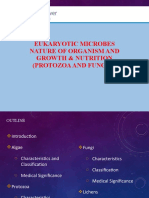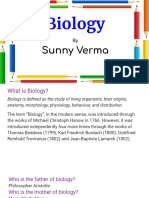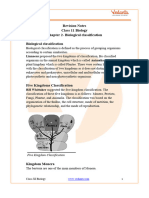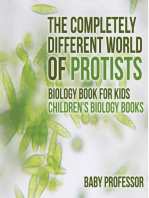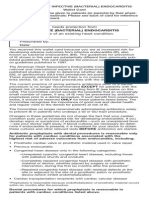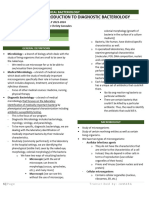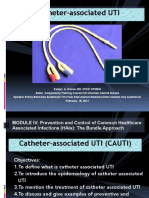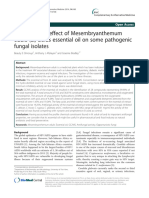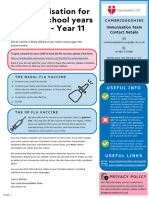0 ratings0% found this document useful (0 votes)
1 viewsMicrobial-Diversity-Eukarya-Microbes
Microbial-Diversity-Eukarya-Microbes
Uploaded by
Jusseljien CataagMICROPARA
Copyright:
© All Rights Reserved
Available Formats
Download as PDF, TXT or read online from Scribd
Microbial-Diversity-Eukarya-Microbes
Microbial-Diversity-Eukarya-Microbes
Uploaded by
Jusseljien Cataag0 ratings0% found this document useful (0 votes)
1 views26 pagesMICROPARA
Copyright
© © All Rights Reserved
Available Formats
PDF, TXT or read online from Scribd
Share this document
Did you find this document useful?
Is this content inappropriate?
MICROPARA
Copyright:
© All Rights Reserved
Available Formats
Download as PDF, TXT or read online from Scribd
Download as pdf or txt
0 ratings0% found this document useful (0 votes)
1 views26 pagesMicrobial-Diversity-Eukarya-Microbes
Microbial-Diversity-Eukarya-Microbes
Uploaded by
Jusseljien CataagMICROPARA
Copyright:
© All Rights Reserved
Available Formats
Download as PDF, TXT or read online from Scribd
Download as pdf or txt
You are on page 1of 26
MICROBIAL DIVERSITY
PART 2: EUKARYOTIC MICROBES
MICROBIOLOGY AND PARASITOLOGY
Prepared by: Ms. Lhea Mae B. Edang
EUKARYOTIC
MICROBES
Characteristics and Classifications
Eukaryotic microbes include some species of :
• algae
• fungi
• protozoa
• lichens
• slime molds.
Algae Fungi
Protozoa Lichens
Slime Molds
ALGAE
are photosynthetic, eukaryotic In addition, some algal cells have pellicle (a thickened
organism that, together with cell membrane), stigma (a lightsensing organelle, also
protozoa, are classified in the second known as an eyespot), and flagella.
kingdom (Protista) of the five
kingdom of classification. Although they are not plants, algae are more plantlike
Phycology (algology) – study of algae than protozoa.
Phycologist (algologist) – a person Algae range in size from tiny, unicellular, microscopic
who studies algae organisms (e.g., diatoms, dinoflagellates and desmids)
All algal cells consist of a cytoplasm, a to large, multicellular, plantlike seaweeds.
cell wall, a cell membrane, a nucleus, Not all algae are microorganisms
plastids, ribosomes, mitochondria and
golgi bodies. Algae produce their energy by photosynthesis
Most algal cell wall contain cellulose
EXAMPLE OF ALGAE
1. Diatoms – tiny, usually unicellular
algae that live in both freshwater and
seawater. Important members of
phytoplankton
EXAMPLE OF ALGAE
1. Dinoflagellates
– are microscopic,
unicellular,
flagellated often
photosynthetic
algae. Responsible
for what is known
as “red tides”
PROTOZOA
Protozoa – are eukaryotic Most protozoa are unicellular
organisms that, together with Most of them are free-living
algae, are classified in the second organisms found in soil and water.
kingdom of the five kingdom Animal-like
system of classification. Have no chlorophyll and cannot
Protozoology – study of protozoa make their own food by
photosynthesis
Protozoologist – a person who
Do not have cell wall, but some
studies protozoa - possess pellicles
EXAMPLES
OF
PROTOZOA
AMOEBIASIS
DISEASE
EntamoebaCAUSING
histolytica = onePROTOZOA
medically important ameba which
causes amebic dysentery and
extraintestinal amebic abscesses.
PRIMARY AMEBIC
MENINGOENCEPHALITIS
(PAM)
Naegleria fowleri = causative agent
of primary amebic
meningoencephalitis
AFRICAN
SLEEPING
SICKNESS
Trypanosoma brucei
= transmitted by
tsetse fly, causes
African sleeping
sickness
TRICHOMONIASIS
CHAGAS DIESEASE
Trichomonas vaginalis = causes
Trypanosoma cruzi = causes persistent sexually transmitted
American trypanosomiasis infections of the male and female
genital tracts
FUNGI
Fungi – are a diverse group that are now classified across
three-kingdoms. Those that are pathogenic to humans and
animals are placed in the Kingdom Fungi (also called
eumycota)
Mycology – study of fungi
Mycologists – person who studies fungi
Saprophytic fungi – living on organic matter in water and soil
Parasitic fungi – living on and within animals and plants
Beneficial fungi – important in the production of cheeses,
beer, wine and other foods a swell as certain drugs (the
immunosuppressant drug cyclosporine), antibiotics (penicillin).
1. YEASTS – are eukaryotic, single-celled organisms that lack mycelia.
DISEASE CAUSING PROTOZOA
▪ C. albicans and C. neoformans are examples of yeast that cause human
infection.
Candidiasis is a fungal infection Cryptococcosis is a pulmonary or
caused by an overgrowth of a type disseminated infection acquired by inhalation
of yeast that lives on your of soil contaminated with the encapsulated
body (Candida albicans) yeasts Cryptococcus neoformans or C. gattii.
I. MOULDS – fungi often seen in water and soil and on food.
DISEASE
▪ P. infestans =CAUSING PROTOZOA
potato blight mold that caused a famine in Ireland
Potato late blight caused by Phytophthora infestans is the most
devastating disease of potatoes and one of the most devastating plant
diseases of any crop.
LICHENS
Lichens – appear as colored often Symbionts – partners in the
circular patches on tree trunks and relationship A lichen represents a
rocks. particular type of relationship
Is a combination of two or three known as mutualism.
organisms: an alga (or Lichens are classified as protists.
cyanobacterium), a fungus and a yeast. foliose lichens: leaflike, crustose
Symbiotic relationship – close lichens: crusty, fructicose lichens:
relationship shrubby
SLIME MOLDS
Slime molds – found in soil and on rotting logs, have both fungal
and protozoal characteristics and have recently been transferred
out of the Kingdom Fungi and placed in the Kingdom Protozoa.
Have a very complex life cycle, initially starting as an ameba, but
progressing into a multicellular organism.
They are not known to cause human disease.
You might also like
- MicrobiologyDocument83 pagesMicrobiologyGian Carlo Hizon100% (4)
- Lesson Note On Biology SS1 Third TermDocument52 pagesLesson Note On Biology SS1 Third TermchrizyboyziNo ratings yet
- Lesson 01 What Are Protozoa - Definition, Characteristics & ExamplesDocument4 pagesLesson 01 What Are Protozoa - Definition, Characteristics & ExamplesGwendolyn CalatravaNo ratings yet
- Protist (Group) 3Document41 pagesProtist (Group) 3Joanna Bee Rose MagyawiNo ratings yet
- Xi - Ut-I CH.02Document21 pagesXi - Ut-I CH.02Gargi SapteNo ratings yet
- Micropara ReviewerDocument9 pagesMicropara ReviewerTricia Maxine DomingoNo ratings yet
- Classification of ProtistsDocument46 pagesClassification of ProtistsrameenremNo ratings yet
- Biological Classification Full NotesDocument7 pagesBiological Classification Full NotesPUSHPANJALINo ratings yet
- FUNGI AND PROTOZOA - BSEdIIIPDocument57 pagesFUNGI AND PROTOZOA - BSEdIIIPKarl Francis GarciaNo ratings yet
- Week 5Document3 pagesWeek 5DELOS SANTOS JESSIECAHNo ratings yet
- UntitledDocument7 pagesUntitledtedy yidegNo ratings yet
- 11th Bio NotesDocument167 pages11th Bio NotesKomalNo ratings yet
- Biology Chapter 2Document10 pagesBiology Chapter 2detective.vijay91No ratings yet
- Chapter 77protozoaDocument11 pagesChapter 77protozoaduraiakilaNo ratings yet
- 1 Lec HistoryDocument10 pages1 Lec Historycharizepascual110899No ratings yet
- Eukaryotic Microbes Nature of OrganismDocument45 pagesEukaryotic Microbes Nature of OrganismJayrelle D. SafranNo ratings yet
- Lesson 02 What Are Fungi - Types and CharacteristicsDocument4 pagesLesson 02 What Are Fungi - Types and CharacteristicsGwendolyn CalatravaNo ratings yet
- MicroPara Prelims 2nd Sem FinalDocument29 pagesMicroPara Prelims 2nd Sem FinalIvan MaximusNo ratings yet
- Week 3 Micro-Organisms Around UsDocument5 pagesWeek 3 Micro-Organisms Around UsolofuvictoragboNo ratings yet
- Groups of Microorganism - 062035Document4 pagesGroups of Microorganism - 062035ismailaabdulrasheed93No ratings yet
- ProtozoaDocument8 pagesProtozoaBhatara Ayi MeataNo ratings yet
- Biological ClassificationDocument5 pagesBiological Classificationshubhamchopra97No ratings yet
- 1.3. Classification of Living ThingsDocument134 pages1.3. Classification of Living ThingsLehn Cruz MiguelNo ratings yet
- Classification of MicroorganismsDocument11 pagesClassification of Microorganismschinazomanyaora13No ratings yet
- Introduction To MicrobiologyDocument13 pagesIntroduction To MicrobiologyBarry AllenNo ratings yet
- BiologyDocument209 pagesBiologyammugolu07No ratings yet
- Chapter 2 (Biology)Document12 pagesChapter 2 (Biology)MahendraKumarNo ratings yet
- CHAPTER 5 ParasitologyDocument29 pagesCHAPTER 5 ParasitologyMerlpa May AlcardeNo ratings yet
- MP Lesson 1 Microbiology and MicroorganismDocument41 pagesMP Lesson 1 Microbiology and MicroorganismJaira MendozaNo ratings yet
- Chapter - 2 Biological Classification - WatermarkDocument22 pagesChapter - 2 Biological Classification - WatermarkLE X KRISHNANo ratings yet
- Chapter 77protozoa: Structure, Classification, Growth, and DevelopmentDocument7 pagesChapter 77protozoa: Structure, Classification, Growth, and DevelopmentGOWTHAM GUPTHANo ratings yet
- Microbiology: M.Tech. ESCM I-Sem, Ii-MidDocument77 pagesMicrobiology: M.Tech. ESCM I-Sem, Ii-MidSai PrasadNo ratings yet
- Biological Classification (Edustudy Point)Document8 pagesBiological Classification (Edustudy Point)canyouguess18No ratings yet
- PROTISTS HandoutsDocument6 pagesPROTISTS HandoutsJoanna Bee Rose MagyawiNo ratings yet
- Infection ControlDocument71 pagesInfection ControlARra Odeza100% (1)
- Chapter-2 (Biology)Document24 pagesChapter-2 (Biology)pramod peterNo ratings yet
- Microworld and You 1Document71 pagesMicroworld and You 1Alyssa Mae Navales100% (1)
- 2862527145313Document79 pages2862527145313dawit gNo ratings yet
- Ch2 BioDocument10 pagesCh2 BiohimanshusinghalwinNo ratings yet
- Class 11 Biology Chapter 2 - Revision NotesDocument10 pagesClass 11 Biology Chapter 2 - Revision NotesNupur kumariNo ratings yet
- Microbiology PPT Week 1Document11 pagesMicrobiology PPT Week 1marianawad0No ratings yet
- XI Chapter-2 Biological Classification (Final)Document45 pagesXI Chapter-2 Biological Classification (Final)95225gnjydNo ratings yet
- Biological ClassificationDocument34 pagesBiological Classificationankitmohanty293No ratings yet
- Unit 4 - Monera, Protists, Fungi and Viruses - StudentsDocument40 pagesUnit 4 - Monera, Protists, Fungi and Viruses - StudentsajtorresbritoNo ratings yet
- Topic 1A Main Themes (AM)Document58 pagesTopic 1A Main Themes (AM)marianawad0No ratings yet
- Microbiology: Protist UnitDocument31 pagesMicrobiology: Protist UnitKerstin LabradorNo ratings yet
- Eukaryotic MicroorganismsDocument55 pagesEukaryotic MicroorganismsHeather Lorraine Majarocon AballeNo ratings yet
- Biological ClassificationDocument9 pagesBiological ClassificationAdarsh Chobey0% (1)
- (I2M Week 6-7) Multicellular PathogensDocument40 pages(I2M Week 6-7) Multicellular PathogensellaNo ratings yet
- CH 10 ClassificationDocument42 pagesCH 10 ClassificationRediat GossayeNo ratings yet
- Intro mycologyDocument4 pagesIntro mycologyflordeaguila4No ratings yet
- 2.2 Introduction in Protozoa - GeneralitiesDocument15 pages2.2 Introduction in Protozoa - GeneralitiesnickswipoNo ratings yet
- Characterizing and Classifying EukaryotesDocument4 pagesCharacterizing and Classifying EukaryotesKiana Valerie MirandaNo ratings yet
- CHAPTER 5 ParasitologyDocument35 pagesCHAPTER 5 ParasitologyMerlpa May AlcardeNo ratings yet
- Bio CH 2 Class 11Document6 pagesBio CH 2 Class 11riteshmeena2007No ratings yet
- Microbiology Assignment: Microbial Diversity MollicutesDocument7 pagesMicrobiology Assignment: Microbial Diversity MollicutesVidushi GuptaNo ratings yet
- The Antibiotic Alternative: The Natural Guide to Fighting Infection and Maintaining a Healthy Immune SystemFrom EverandThe Antibiotic Alternative: The Natural Guide to Fighting Infection and Maintaining a Healthy Immune SystemRating: 5 out of 5 stars5/5 (1)
- The Lives of Fungi: A Natural History of Our Planet's DecomposersFrom EverandThe Lives of Fungi: A Natural History of Our Planet's DecomposersNo ratings yet
- The Completely Different World of Protists - Biology Book for Kids | Children's Biology BooksFrom EverandThe Completely Different World of Protists - Biology Book for Kids | Children's Biology BooksNo ratings yet
- Wallet Card Prevention of Infective (Bacterial) EndocarditisDocument2 pagesWallet Card Prevention of Infective (Bacterial) EndocarditisAline Caroline SouzaNo ratings yet
- Vaccination Record InglesDocument1 pageVaccination Record Inglescidaparecida141977No ratings yet
- Introduction To Diagnostic MicrobiologyDocument11 pagesIntroduction To Diagnostic Microbiologygonchacha.11No ratings yet
- Catheter-Associated UTIDocument54 pagesCatheter-Associated UTIAmeng GosimNo ratings yet
- First Aid PDFDocument100 pagesFirst Aid PDFBettyblazetech100% (3)
- TASK 1 ENGLISH OgiDocument6 pagesTASK 1 ENGLISH OgiOgi malik FajarNo ratings yet
- Lab Technologist-2Document32 pagesLab Technologist-2AHAMED SHIFAANNo ratings yet
- Diagnosis of Important Bacterial DiseasesDocument41 pagesDiagnosis of Important Bacterial DiseasesIsaacJ22No ratings yet
- Made W RizzDocument11 pagesMade W RizzVansh GroverNo ratings yet
- NEET PG 2020 Question Paper With AnswersDocument23 pagesNEET PG 2020 Question Paper With AnswersMimiNo ratings yet
- Science Class 10 Notes For Diversity in Living OrganismsDocument2 pagesScience Class 10 Notes For Diversity in Living Organismsmanal ahemadNo ratings yet
- Reading Comprehension Passage 1 Read The Passage Below and Answer The Questions That FollowDocument3 pagesReading Comprehension Passage 1 Read The Passage Below and Answer The Questions That FollowadiG48 AtdiG48No ratings yet
- English Course: Pharmacy StudentsDocument36 pagesEnglish Course: Pharmacy StudentsAmida UrfaNo ratings yet
- Semester Chapter 2 - Special PathologyDocument209 pagesSemester Chapter 2 - Special PathologyALWIN SEBASTIANNo ratings yet
- PR 1Document3 pagesPR 1Liezel joy Dela TorreNo ratings yet
- The Inhibitory Effect of Mesembryanthemum Edule Bolus Essential Oil On Some Pathogenic Fungal IsolatesDocument7 pagesThe Inhibitory Effect of Mesembryanthemum Edule Bolus Essential Oil On Some Pathogenic Fungal IsolatesDaniel MarţuneacNo ratings yet
- CPHM Midterm Transes Lesson 6Document8 pagesCPHM Midterm Transes Lesson 6Chrischelle MendozaNo ratings yet
- TBL NSP 02 September 2020Document173 pagesTBL NSP 02 September 2020Hiwotu KassawNo ratings yet
- Biosafety and Biosecurity Module 4, Part 1Document16 pagesBiosafety and Biosecurity Module 4, Part 1Aio MinNo ratings yet
- Reading Skill 10Document8 pagesReading Skill 10Naila DwinovaNo ratings yet
- English-6-Q2-Module-1-Lesson-2-Palpallatoc - Lydia E. - FINALDocument15 pagesEnglish-6-Q2-Module-1-Lesson-2-Palpallatoc - Lydia E. - FINALDanielLarryAquinoNo ratings yet
- Mind Map TonsillitisDocument1 pageMind Map TonsillitisKubraNo ratings yet
- Gram Positive Bacteria of Medical ImportanceDocument12 pagesGram Positive Bacteria of Medical ImportanceGeorge C. KasondaNo ratings yet
- Ican Legal Victories PDFDocument8 pagesIcan Legal Victories PDFGabriel Antonio NájeraNo ratings yet
- Cambridgeshire Flu ConsentDocument2 pagesCambridgeshire Flu ConsentKingsley JonNo ratings yet
- NCISM Roga Nidana Vikriti Vijnana syllabusDocument8 pagesNCISM Roga Nidana Vikriti Vijnana syllabusaarya.jayaramanNo ratings yet
- Science Class 5 PaperDocument3 pagesScience Class 5 Paperjawadkhantanoli71No ratings yet
- Anti-Streptolysin "O" Latex Test: Group 5Document16 pagesAnti-Streptolysin "O" Latex Test: Group 5rowenanuquiNo ratings yet
- Ammonium Salts of Carbamodithioic Acid As Potent Vaginaltrichomonacides and FungicidesDocument12 pagesAmmonium Salts of Carbamodithioic Acid As Potent Vaginaltrichomonacides and FungicidesSantosh YadavNo ratings yet
- Environmental Sanitation: Integrated Health Delivery ProgramsDocument90 pagesEnvironmental Sanitation: Integrated Health Delivery ProgramsGege LianNo ratings yet















